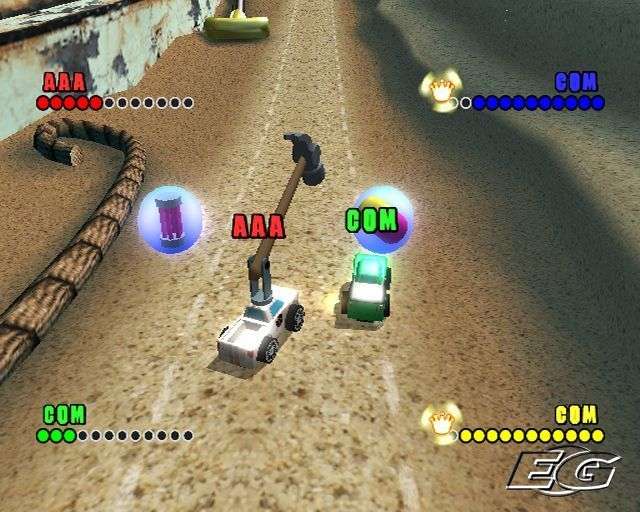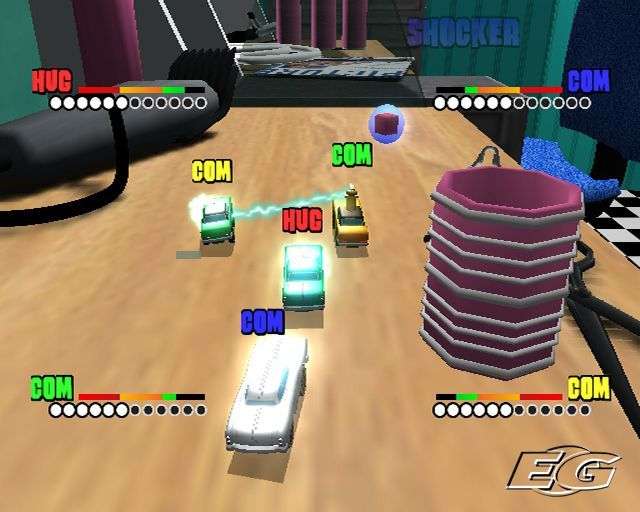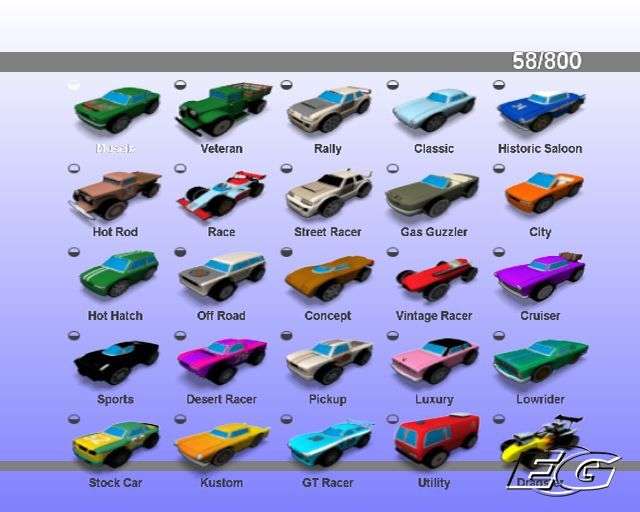Micro Machines V4
Back to the Future II.
In this contrary world that we inhabit, you get used to contrasting opinions about everything. If the BBC collared Sven Goran Eriksson about his thoughts on the rebirth of Micro Machines V4, he'd probably peer balefully over his glasses, do his best owl impression, surreptitiously emit a pellet and come to the conclusion that "we got the right result" and hoot that it "played well" while skirting wistfully over the issue and managing to avoid giving us any real insight into the matter.
The pundits back in the studio, meanwhile, would be in no mood to pay lip service to Supersonic for the sake of blind nostalgia. It might be eight years since V3 graced the PSone, but Alan Hansen would point out the defensive naivety, and highlight the glaring predictability in Codemasters' tactics and suggest things need freshening up if it is to compete on the world stage. Then we'd get a cheeky wink from Gary Lineker who would lighten the mood with a quip about David Darling's hair and surmise that it was an efficient return to the starting line-up for the veteran franchise.
And then we'd cut to some cheery, beery fans, celebrating their recent multiplayer result and chanting "Genius at play!" They'd be barely able to string a coherent sentence together, but would be full of song and infectious joy. Who cares what the nasty old critics think?
Old dog, new tricks?
But the nasty old critics can't really do anything other than report that Micro Machines V4 hasn't exactly moved on a great deal. It's not really any better or worse despite Codemasters and Supersonic's lengthy break from the franchise (you might also recall that Infogrames had a brief stint back in late 2002, but it flopped despite being ok-ish), it does the job just fine in either single or multiplayer across a few basic modes and with a few minor twists and additions. Despite the general lack of effort to move things forward, you just know it will score a few nostalgia points for those of you who haven't owned a thrilling, fast-paced top-down racer since the '90s.
Like a lot of old classics, the key is to V4's enduring appeal is the simplicity and purity of the gameplay, and when someone releases a game that offers as much unpretentious fun as this, the fact that it's a flagrant retread with little in the way of new ideas is not a major problem so long as the price is right. For many, the very fact that Supersonic hasn't tinkered unnecessarily with its own winning formula will be welcomed.
With that in mind, you'll know the drill by now. As ever, the main meat of the game is to race against up to three other miniature cars across various wacky environments: kitchens, snooker tables, sewers, shopping malls, you name it. The pseudo overhead viewpoint is retained, with a panning, zooming camera able to shift dynamically to ensure all the racers are in full view and so that tricky corners can be (in theory) negotiated with unobtrusive ease, and once again the tracks are littered with weapons to aid you on your charming little quest.
Driver free

Unlike previous legendary Micro Machines of old, you don't get to choose from a selection of cute/crazy looking drivers, and this feels like an oversight. Instead, you dive headlong into a series of bland menus (with a cheap gurgling early '80s electro loop burbling over the top) which house the various Micro Tournaments, with three difficulty settings and four different divisions to conquer. Within each division you'll normally have to win three races of each type - Battle Cup, Team Battle Cup, Race Cup, Checkpoint Cup and Battle Lóeague.
The basic Battle mode you'll definitely remember - here you try to build up a decent enough lead to score a point. Each contestant starts off with four points and wins one for getting far enough ahead (or being the last car standing), or loses one for being in last place, with no points lost for being the middle car. The winner is the one who clocks up eight points. Simple, classic, and occasionally a lot of fun. To help you on your way, each track is littered with numerous weapons and power-ups, such as the plasma gun, dice bombs, a giant hammer, missile, double damage, daisy cutter, pea shooters, hair drier, flame thrower, iron rain, oil slicks and various others. Each respawns after every lap, and so much of the racing strategy comes from not only memorising the corners and hazards, but which are the best weapons to collect. Loading the track with dice bombs, for instance, can be a great strategy for the subsequent lap by tripping up opponents that have streaked ahead, while the plasma gun and machine gun help slow down opponents by damaging their vehicle. Team Battle, meanwhile, is identical apart from the fact that you're vying for points in a straight tug of war between you and the CPU collectively. So, if you get far enough ahead, you win and score a point. If you fall too far behind, or fall off the track, that's one point docked - regardless of your position in the pack.
Same again

Race mode, meanwhile, is another basic MM favourite, where the leader after three laps wins. In this mode in particular, you really have to make full use of the best weapons and drive with a lot of skill to prevent the wily AI from getting ahead - who, from our experience, provide a stern test on the default medium skill level. Checkpoint mode, though, is just you on your lonesome trying desperately to reach the next checkpoint before the time runs out. With several laps to complete, this is perhaps the trickiest of all to pull off thanks to tight time limits and the need to race almost the perfect lap in order to squeak through some of the challenges.
As you complete each challenge you'll win some of the 750 vehicles in the game, or sometimes an entire box set if you manage to conquer all three challenges in each mode. Unlike V3, this is all about four-wheelers, and there are 25 different classes in all, encompassing desert racers, cruisers, GT, stock car, saloon, concept, low rider, sports, utility, rally and loads more. It's not abundantly clear what the point of having so many cars in the game is when the vast majority of them handle in exactly the same way. Often the only difference between the cars is their colour, which seems arbitrary to say the least, and unlocking dozens of vehicles doesn't exactly feel like a reward for your efforts. The difference between the vehicles is only truly apparent with some of the more unique types, like the truck. Less is definitely more in this instance.
Perhaps the most charming (or annoying, depending on how you look at it) new addition is the increased interaction with the environments this time around. One of the early checkpoint races has you weaving in and out of the gaps on a fast-moving model train, and then there's the classic task of avoiding oncoming balls and dodging a flailing cue on the snooker table track. After a while, what you really notice about V4 is how much the track design has moved on since the early days, with much more emphasis on depth in the tracks provided by the roving 'eye in the sky' 3D engine. Anyone who's played the recent Mashed! games from Supersonic will be able to spot a certain amount of crossover in the design sensibilities, albeit with a much better behaved dynamic camera system, so thanks for sorting that out, chaps. Top marks, too, for allowing us to change to a 'classic' fixed isometric view if we wish - sometimes you just want the old school charm, and being able to permanently switch it in the menu settings is a great idea. There's even a 'retro' cam to unlock for those of you who prefer the old top-down view, which is nice.
As ever with these sorts of games, there's a certain reliance on memorising the track layout before you can really start to have fun; at first, you'll constantly be driving blind if you're the one in the lead. The camera does zoom out to compensate in these situations, but places you right on the edge of the screen, making it impossible to react to sudden corners and obstacles. Of course, the AI doesn't have this problem, so it's a pretty fundamental design flaw right from the word go. It's not an issue that stops it being fun long term, but you'll sure as hell be frustrated whenever a new track unlocks, and you'll be quite surprised how tough most of the game is - even on the supposedly 'easy' setting. Luckily the stop-start nature of the game isn't marred by long loading waits - a crucial point that makes it slightly less frustrating to play the same track 25 times in a row before you finally win.
Buy it again

One area of consternation is that 10 tracks in the PS2 version are effectively 'locked' until you 'trade' them with the PSP via a link-up. We're not sure if this is a bonus, or just someone's clever idea to try and get people to buy both, but basically the PSP will, ahem, import 10 multiplayer (or single-player practice) tracks from the PS2 version, and vice versa when you link-up. Not having the PSP version to hand, we couldn't test this, but it's an idea we're not sure we want to see encouraged too much.
Talking of multiplayer, it's arguably in this mode where the game really comes into its own, and V4 doesn't disappoint - as long as you're not worried about the lack of PS2 online functionality (the PC version sports LAN and online play, DS and PSP feature wireless). Whichever version you go for, and whatever settings you tweak, essentially you can go for All Against All (first to fill up their points bar) or Team Game (first team to fill their points bar). The PS2 version has the added advantage of four-player support (via the dreaded multitap) on the same machine, or even eight-player if you share controllers. This completely bizarre Twister-esque scenario is something that should perhaps be saved for drunken parties, however, as it's a lot harder to pull off that you might think and completely open to sabotage as both players wrestle with an analogue stick each and either the dpad or the buttons . If it really bothers you, you can either play for fun or play for keeps and trade cars in order to fill up your collection. It's all good clean fun, but maybe just a liiiiitle pointless if you ask us.
As an added bonus, there's a built-in track editor that allows you to mess around with three of the basic environments to choose from. It's all pretty basic stuff, whereby you have to connect up way points and choose power-up placement. Even the most technophobic player could create their own unique route, and challenge their mates on something truly evil, but it is fairly limited in scope, in that you can't actually build your own tracks or anything.
Old gen

Even though V4's not a game that you expect to be wowed by in technical terms, it's still pretty disappointing that the game's environments aren't a little more impressive than they are. Like much of the game, it's all fairly basic, perfunctory low-poly, low-textured stuff, and while some levels are infinitely more imaginative than others, some appear knocked up in a hurry to pad out the content. It's a not game to be played on that big HDTV you've just splashed out on, put it that way, so save it for a small, knackered old CRT that can do it justice. Purely as an observation, the one-off Infogrames version of Micro Machines looked prettier than this, and that was nearly four years ago, but fortunately it really makes no real difference to the 15 year-old gameplay at the core.
We're certainly not going to moan about the re-emergence of Micro Machines - it's still as fun and addictive as it ever was, and in many ways we'd place it up there with Mario Kart as one of those games you need to have a copy of in your collection for those inevitable post-pub sessions. It's a shame, though, that Codemasters has (once again, tut) dismissed the potential of online play on the PS2, and - bizarrely - has chosen not to bother with an Xbox version at all (a 2d Xbox Live Arcade version on 360 would be perfect, thinking about it...) . Still, it's a fab little game that's as unpretentious as they come and it's good to have it back - it's just a shame that the concept hasn't really moved on to any degree in the intervening years. Next time, Codies, please show a little more ambition and give fans more than the rehash that this so evidently is.

